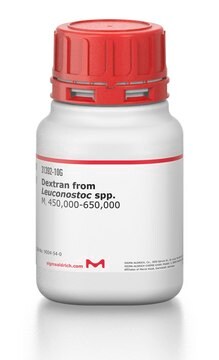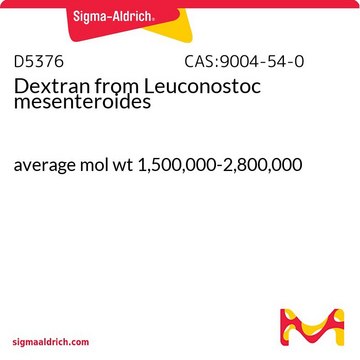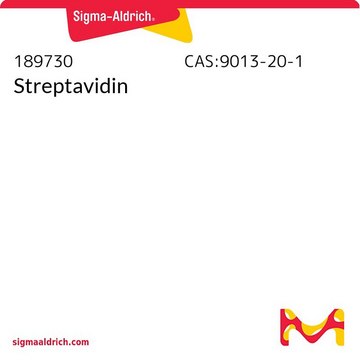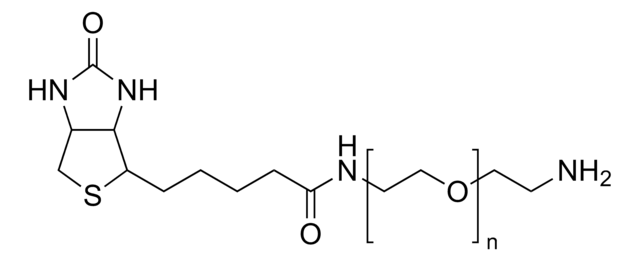Recommended Products
conjugate
biotin conjugate
Quality Level
form
powder
mol wt
10,000
extent of labeling
~2 mol per mol
color
white
solubility
H2O: soluble 50 mg/mL, clear, colorless to faintly yellow
storage temp.
2-8°C
Looking for similar products? Visit Product Comparison Guide
Application
Biotin-dextran is used in tissue staining to prepare neurons for detection by avidin-conjugated detection systems. It is taken up by neuronal processes and transported bi-directionally. It infiltrates axon boutons in the anterograde direction and dendritic processes in the retrograde direction. Staining can be observed in fixed and sectioned tissue from two days to two weeks after biotin-dextran is injected into the brain or spinal cord. It can also be applied to cut nerve tracts. Biotinylated neurons are detected by either light or electron microscopy following incubation with avidin-horseradish peroxidase conjugate and the electron-dense substrate 3,3′-diaminobenzidine (DAB).
Other Notes
To gain a comprehensive understanding of our extensive range of Dextrans for your research, we encourage you to visit our Carbohydrates Category page.
Storage Class Code
11 - Combustible Solids
WGK
WGK 3
Flash Point(F)
Not applicable
Flash Point(C)
Not applicable
Personal Protective Equipment
dust mask type N95 (US), Eyeshields, Gloves
Choose from one of the most recent versions:
Already Own This Product?
Find documentation for the products that you have recently purchased in the Document Library.
Customers Also Viewed
C Brösamle et al.
Journal of neurocytology, 29(7), 499-507 (2001-03-30)
The corticospinal tract (CST) of the rat is a widely used model system in developmental, physiological, and regeneration studies. The CST of the rat consists of a main tract, that runs in the dorsomedial funiculus and several minor components. We
Karen M Fisher et al.
The Journal of comparative neurology, 526(15), 2373-2387 (2018-07-18)
The corticospinal tract (CST) forms the major descending pathway mediating voluntary hand movements in primates, and originates from ∼nine cortical subdivisions in the macaque. While the terminals of spared motor CST axons are known to sprout locally within the cord
Giam S Vega-Meléndez et al.
Journal of neuroscience research, 92(1), 13-23 (2013-10-30)
Neurotrophins such as ciliary neurotrophic factor (CNTF) and brain-derived neurotrophic factor (BDNF) and growth factors such as fibroblast growth factor (FGF-2) play important roles in neuronal survival and in axonal outgrowth during development. However, whether they can modulate regeneration after
Jia Liu et al.
Journal of the neurological sciences, 325(1-2), 127-136 (2013-01-16)
The stem cell-based experimental therapies are partially successful for the recovery of spinal cord injury (SCI). Recently, acellular spinal cord (ASC) scaffolds which mimic native extracellular matrix (ECM) have been successfully prepared. This study aimed at investigating whether the spinal
Prefrontal cortical inputs to the basal amygdala undergo pruning during late adolescence in the rat.
Victoria L Cressman et al.
The Journal of comparative neurology, 518(14), 2693-2709 (2010-05-28)
Transformations in affective and social behaviors, many of which involve amygdalar circuits, are hallmarks of adolescence in many mammalian species. In this study, using the rat as a model, we provide the first evidence that afferents of the basal amygdala
Our team of scientists has experience in all areas of research including Life Science, Material Science, Chemical Synthesis, Chromatography, Analytical and many others.
Contact Technical Service








